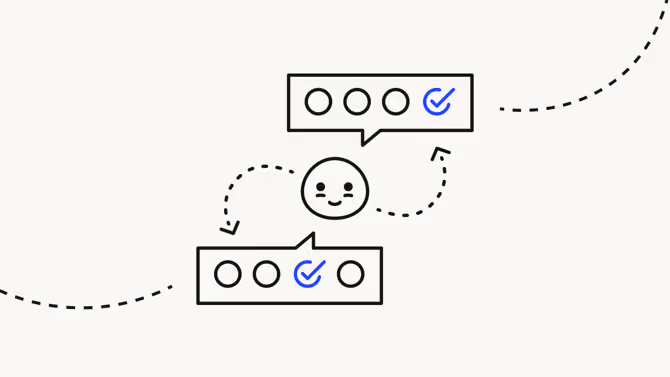Succession planning guide: Developing a talent pipeline

Career development plan template

A critical employee unexpectedly left the business. What now? Without a replacement lined up, your company could really be left in the lurch.
Succession planning is your safeguard against this possibility. It helps identify and train top-performing candidates who can take over crucial roles when the current generation departs. For businesses that want long-term stability and talent continuity, succession planning is too important to ignore.
In this succession planning guide, we offer a step-by-step framework for forming your own plan and discuss a few best practices.
What is succession planning?
Succession planning establishes which roles are crucial to business operations and prepares employees to take over these positions when key colleagues depart. Mentoring replacement candidates over time ensures they have the skills and knowledge required to step in when needed.
It’s a long-term strategy that ideally starts far before a role becomes vacant. The aim is to minimize the disruption caused by the departure of key colleagues.
The importance of succession planning
Succession planning benefits both organizations and employees.
When important roles are vacant, productivity can suffer as other employees pick up the slack. Even worse, depending on the nature of the role, operations may have to pause entirely. Succession planning avoids these eventualities, as well as the costly external hiring process. HR doesn’t have to spend time interviewing and training new candidates when you already have the right person on payroll.
For employees, succession planning grants them the opportunity to develop their skills. The process also highlights a potential career path within the organization, making them aware of future advancement opportunities. As they develop, they may also prove worthy of added responsibilities or even an interim promotion.
The risk of not having a succession plan
Here are a few potential risks of not having a well-structured succession plan:
- Leadership gaps: Without leadership, teams can be left directionless. When these roles are empty, employees scrabble to understand what’s required of them.
- Decreased morale: The stress of a sudden departure worsens if other employees have to pick up the slack. Everyone must work harder to keep things running.
- Reduced employee retention: Without a succession plan, it’s tricky to identify who has the talent to replace a recent departure. And passing on clearly suitable candidates for such a promotion could lead them to question their future at the company.
- Lost knowledge: Critical roles often come with a vital understanding of business processes. Not training a replacement before a departure means this knowledge could be lost for good.
Key elements of business succession planning
Here are the core elements that make up the succession planning strategy process.
Clear role definitions and requirements
Clearly establishing which roles are important, their main responsibilities, and skill requirements makes it easier to identify the best-suited replacements if required. This process will also highlight any additional training they may need.
Ongoing performance evaluations
Succession planning typically targets top-performing employees, making ongoing performance evaluations an important part of the process. Tools like Workleap Performance make conducting performance evaluations a breeze. Its easy-to-read structured data aids in identifying and supporting talented workers.
Skills gap analysis
Skills gap analysis identifies the difference between current knowledge levels and where employees need to be. For succession planning, this establishes how ready an employee is to take on a role and whether they require any additional development.
Leadership development programs
Leadership roles are usually the most senior positions available, so when they’re left vacant, companies lack direction. Leadership development programs identify individuals with the talent to succeed at the highest level, providing them with the necessary tools and skills.
Continuous communication and feedback
Check in with employees who have succeeded former employees. Enquiring how prepared an individual felt when they were asked to step into a key role offers insight into the effectiveness of the process. Feedback like this is useful when it comes to refining succession planning strategies.
How to create a succession plan: Step-by-step guide
Here’s an actionable roadmap for creating a successful succession planning setup.
Step 1. Identify critical roles
The first step is identifying which positions are critical to achieving the organization's strategic goals. These are usually leadership roles, but could also include those that require a specialized skill set.
Step 2. Define success criteria
After identifying a role, outline the skills, traits, and experience level the ideal candidate would have. Establish whether there are any specialist skill requirements that would call for additional training or mentoring.
Step 3. Assess internal talent
After mapping out the requirements for a position, conduct a skills analysis to identify internal talent. Succession planning isn’t an immediate process, so rather than just assessing current performance, look for future potential.
Tools like Workleap Performance help with recording and categorizing employees' skill sets.
Step 4. Create development plans
Begin planning the development of individuals with potential. Use the skills analysis process to compare where they are now to where they need to be to tackle the role. This will help establish which learning and mentorship programs are required.
Step 5. Test readiness
Where possible, supplement learning opportunities with simulated or real challenges. For example, if an employee is picked for a management role, have them run a short-term project team to test leadership readiness. These opportunities allow employees to apply their knowledge in practical situations and gain firsthand experience of responsibilities they will eventually assume.
Step 6. Document and communicate
Ensure the individual projected to take over a role is fully looped into the process. They should understand the detailed demands of the new position and the efforts required to get them there. This transparency builds trust and clarity, and ensures they can hit the ground running.
Step 7. Review and adapt regularly
Succession planning should be a flexible process that aims to adapt to the changing needs of an organization. By adjusting plans, reassessing employees, and finding new learning opportunities, HR teams can continuously make their plans more effective.
Request feedback to assess employee engagement with a succession plan, and use it to refine future programs. Ask whether the employee felt adequately prepared to tackle the role, if they fully understood the demands of the new position ahead of time, and what they believe could’ve been done better.
Best practices for succession planning
Build a more effective process by incorporating the following succession planning best practices.
Start early and be proactive
Identify successors as early as possible. Giving potential candidates time to learn and develop maximizes their readiness and helps boost their confidence.
Work collaboratively
While HR teams may lead the process, colleagues currently in key roles can assist by mentoring the next generation. This might include scheduling regular meetings to discuss the role’s demands or allowing the candidate to shadow the senior employee.
Use data and succession planning tools to guide decisions
Platforms like Workleap Performance can help identify candidates with potential by providing data-driven insights on current skill sets and performance levels. Choosing the right people is essential to ensure learning and development investments aren’t wasted.
Provide transparent growth opportunities
Clearly outlining the route to a key role boosts employee motivation by showing candidates what they need to do to get there. People are much more likely to engage with training if they know the end result is career advancement.
Maintain diversity and inclusion
Building diversity and inclusion procedures into succession planning initiatives ensures the process is fair and equitable. This is particularly important for leadership positions, so people from different backgrounds and circumstances are represented at the highest levels.
Embed succession planning in company culture
Embedding succession planning in company culture fosters a learning-focused environment, encouraging active engagement with skills development. Request feedback from potential successors to refine the succession planning process and drive continuous improvement for the next generation of critical employees.
Strengthen leadership planning with Workleap
Succession planning is a central part of organizational strategy. It ensures roles essential to business success aren’t left vacant while also offering a way to reward top performers.
With Workleap Performance, businesses can easily identify potential successors, pinpointing top talent through structured, objective evaluations. Data from Workleap Officevibe can then be used to ensure these candidates are fully aligned and engaged with your organization. These strategies are sure to morph and adapt over time, so Workleap’s tools are designed to help meet emerging business demands.
To see how Workleap can help you build an effective succession planning pipeline, request a demo today.
Clarify roles and responsibilities template


%20(1).avif)


.avif)
.avif)



.avif)




